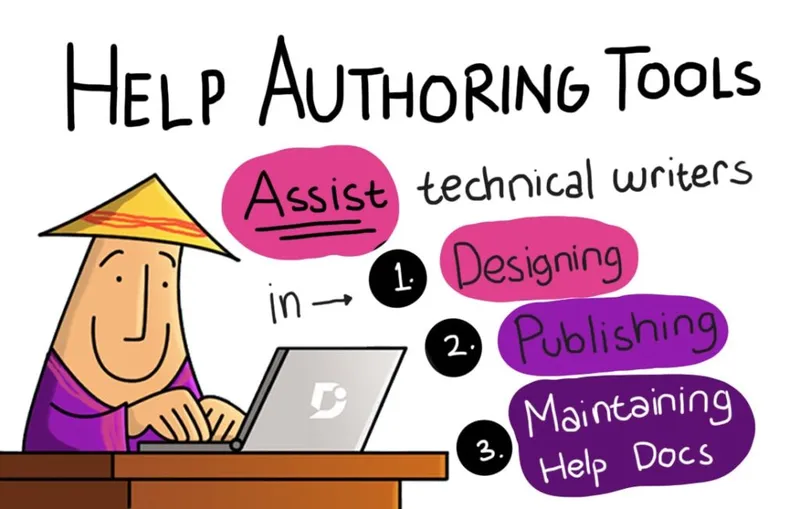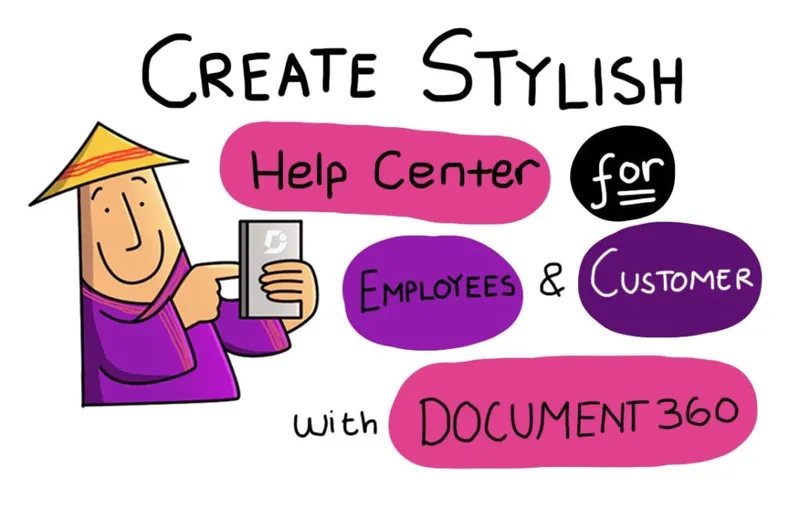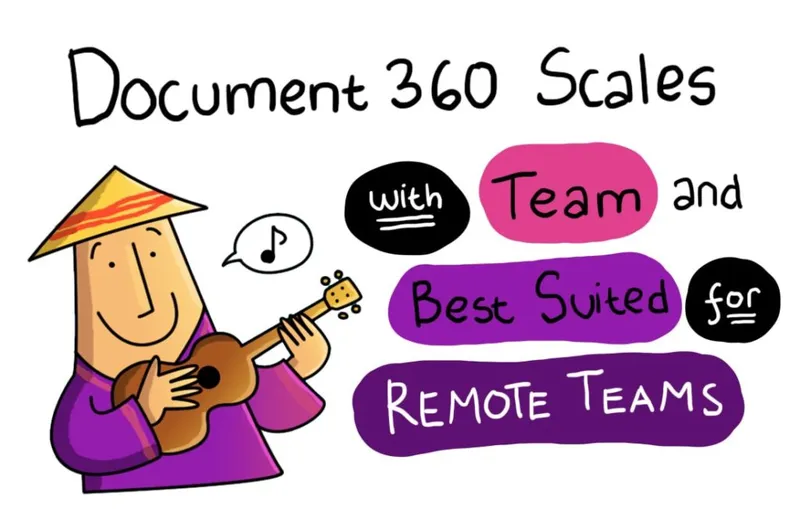

Best Help Authoring Tools for Growing Tech Teams
Different types of businesses require different types of Help Authoring Tools. If you’re not sure what a Help Authoring Tool is, see our post The Help Authoring Software & Tools Lowdown.
The problem when choosing a tool is that in the past, many software solutions have been developed for enterprise customers. These clients are frequently operating in industries with extensive regulatory requirements – for example, pharmaceutical or manufacturing – which often demand large amounts of documentation across many platforms and in multiple formats.

This means that these companies require tools with a wide range of functionality, and Help Authoring Tools ended up being more like a content management database and publishing system bundled together.
The major Help Authoring Tools – such as Madcap Flare and Adobe RoboHelp – cost in excess of $1,000 for the yearly plans. Although they are sold in tiers with individual pricing and functionality, they can still price out the many of the growing tech teams that require some of their functions for their documentation.
And up until fairly recently, these have been the only tools available. You’ll welcome the good news that there is now an expanding market of more specialised Help Authoring Tools sold in a more affordable payment plan.
Document360
Document360 is the best value Help Authoring Tool for growing tech teams. It was created by Kovai for the team’s own documentation needs, at a time when nothing else suitable was available on the market. Essentially, Document360 helps your team create, collaborate, and publish a self-service knowledge base for your software with ease.
When you purchase a subscription, you get a highly optimised, responsive, dynamic knowledge base website with a focus on behind-the-scenes publishing capabilities. It allows you to provide a modern UX website for users – but it’s far more than just a site. The front-end design is optimised using Information Architecture best practices so you can usefully present large amounts of information for your users to learn from.

In Document360, you can write your own documentation in markdown for an in-editor formatting experience, converting your text directly to web-ready HTML. It accelerates the speed at which you can produce live documentation, and you can easily publish and manage your content in the intuitive back-end interface.
Document360 is well-suited for teams by offering intuitive peer review and publishing, versioning and rollback, internal commenting, and previews for how the content will look once published. You can choose different team member roles in case you have people who should access your documentation in read-only mode, or you want to review your content in beta. Document360 allows you to have five team users in the basic plan.
As a development team, Document360 responds quickly to your product feedback on improving the interface functionality. If you don’t currently see a feature in Document360 that you’d like, there’s a good chance they can develop it for you as part of the product roadmap. This is all part of why you get incredible value for money with Document360. It’s a very high quality Help Authoring Tool, and at $49 per month for the startup plan, this works out at only $588 per year.
Stoplight for API teams
Stoplight is another type of Help Authoring Tool that’s aimed at API development teams. Although it’s not cheap, Stoplight is customised to help you produce very robust API documentation that looks very good for your users.
Stoplight has some fantastic functionality that allows you to build your API documentation in minutes using its visual editor, Hubs. Combine your OpenAPI documents (an open source specification to help you design, build, document and consume REST APIs – previously called Swagger) with markdown to create internal and external API documentation. Or, you can use your own API design with Stoplight and still get the same experience.
You can deploy your Stoplight documentation to the cloud with one click, or download the static HTML files to host your documentation anywhere. As documentation is crucial to the success of your API, Spotlight is incredibly useful for API engineering teams and it only costs $24 per user per month. On the other hand, it’s not good value for money for companies who do not want a Help Authoring Tool for this specific purpose.
HelpDocs simple knowledge base
HelpDocs is a Help Authoring Tool that allows you to create a simple knowledge base website for your customers. Even on the basic plan for HelpDocs, you can edit the CSS for your website and customise it to your needs. It allows you to create an authoritative knowledge base to guide your users, cut down on support tickets, and offer a better overall customer experience.
It helps you provide a self-service solution for your customers by allowing you to create infinite subcategories for your content. No matter how complex your documentation ends up being, you can use HelpDocs for your knowledge base. You also have a lot of control over external user permissions, meaning you can heavily customise who can see what content within your HelpDocs knowledge base.
This software is aimed at customer support professionals who would like their Help Authoring Tool to integrate with other software in the customer support stack. This includes Front, Intercom and Drift. It also supports multiple languages with automatic translation of your help content in more than 100 languages in the higher pricing tier, if this is something you’re looking for. HelpDocs begins at $39 a month for five team accounts, which is great value.
Madcap Flare extensive functionality
No list of HATs would be complete without properly discussing Madcap Flare, first released in 2006. It’s an industry standard and used by thousands of businesses across the world. You may be thinking, is Madcap Flare right for my team?

The answer is that Madcap Flare has a dizzying range of functionality, most of which may be irrelevant for your growing tech team. It’s this functionality that makes it worth its price tag at $1,648 a year for the cheapest plan. For example, you have the ability to produce topic-based single-sourced content, which is a very common way to handle your help content in the enterprise. You have lots of files, managed by many different people, over a very long period of time.
With tools like Madcap Flare, your help files are viewed as important data that is stored, tagged and curated for future use. The features of Madcap Flare support this type of workflow and make it a content database. The interface is reminiscent of Windows 95, presumably for the comfort of long-term users. Flare provides a dedicated XML editor for marking up your content with an XML-based tagging system.
It also allows you to produce a customer-facing knowledge base website, but in this case you will need to design and manage the website yourself. Adobe RoboHelp is another industry standard that is again aimed at the enterprise, and has similar capabilities to Flare.
Consider these enterprise tools if you anticipate producing huge amounts of documentation, are operating in an industry with complex and strict regulations, or you’re working with legacy documentation. For companies in these situations, solutions like Flare or RoboHelp may be absolutely essential for your documentation goals. See Tom Johnson’s review of Flare for more information on this topic.
Why Document360 is such good value
Unlike Document360, extremely powerful, generalist Help Authoring Tools have a steep learning curve. This is because they are intended for complex use cases, and whole training courses are dedicated to users of Madcap Flare.

Document360 cuts out all the unnecessary features, focusing instead on giving you a streamlined workflow for your online documentation. It’s perfect for growing tech teams who need a stylish knowledge base for their product – and fast. Document360 also allows for easy front-end code customizations to your website so you can modify it to suit your needs.
Also, in the case of Flare, you have a lot of software functionality to manage your content, but the software and your data must all be stored on your own servers. This means even after you purchase the software, you’re still responsible for buying and maintaining software and hardware infrastructure for your business, as well as paying employees to maintain it.
Since its packaged as Software as a Service, Document360 stores and hosts your data for you – this means you only ever use what you need. It’s an out-of-the-box solution for your rapidly expanding, agile team – and if you need more, you can easily upgrade your plan.
Things to consider before you buy
There are many more questions you need to ask yourself before committing to a new Help Authoring Tool. Do you need translations? What file formatting do you require? How many knowledge bases do you need? How will you be using video, audio, text or image?
Technical Writers can use a wide range of tools in their work, but Help Authoring Tools are specifically designed for creating and managing content. Knowledge base solutions like Document360 are all-in-one tools that offer an internal and external publishing experience, so you can go from zero to public-facing content much more quickly.
On a side note, free Help Authoring Tools will not scale effectively with your business. These include some free open source tools and WordPress plugins. You will only achieve the functionality you need from sophisticated paid SaaS tools like Document360.
Over to you!
There are a few different subcategories of Help Authoring Tool on the market right now. Hopefully you understand what solutions like Document360 have to offer your business and are considering signing up for a trial.
Document360 can be easily afforded by early-stage startups, while still enabling you to move seamlessly between its product tiers as your company grows. It has been specifically designed for agile, rapidly scaling tech teams.
We’ve published many other posts surrounding the types of Help Authoring Tools on the market to help you decide on a solution for your business. Check out The Most Popular Help Authoring Tools Compared and Is MadCap Flare Help Authoring Tool Worth Its Price?




.jpg?mode=crop&crop=faces&ar=1%3A1&format=auto&w=1920&q=75)
